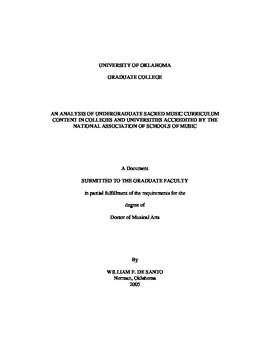| dc.contributor.advisor | Gates, Ed, | en_US |
| dc.contributor.advisor | Magrath, Jane, | en_US |
| dc.contributor.author | De Santo, William F. | en_US |
| dc.date.accessioned | 2013-08-16T12:19:58Z | |
| dc.date.available | 2013-08-16T12:19:58Z | |
| dc.date.issued | 2005 | en_US |
| dc.identifier.uri | https://hdl.handle.net/11244/952 | |
| dc.description.abstract | The purpose of this study was to analyze undergraduate sacred music curriculum content in colleges and universities accredited by the National Association of Schools of Music. The study was designed to answer the following research questions: (1) What course topics are offered in the undergraduate sacred music curriculum among NASM schools? (2) To what extent are the course topics offered? (3) What value do church music faculty place on each course topic in the curriculum? (4) What do church music professors at these schools indicate is necessary to keep the church music degree in North America vital? (5) How do the findings of this study compare with findings of previous studies? | en_US |
| dc.description.abstract | The research was conducted by means of a content analysis of academic catalogs and a survey questionnaire mailed to undergraduate sacred music faculty at seventy NASM schools in the United States. For the content-analysis portion of the study, required course titles from each institution were categorized into major groupings and subgroupings. The survey component sought information relative to the institution and to the sacred music curriculum. Open-ended questions focused on the preference for a master's degree in sacred music, the preference for an undergraduate music education degree, and strengthening the sacred music program in North America. The data in this component of the study are compiled from fifty-one responses, representing 73% of the population. | en_US |
| dc.description.abstract | The topics that received the highest emphasis in sacred music programs among NASM schools were applied voice, choral ensemble, organ literature, music theory, aural skills, and senior recital. Topics that were rated as most important included music theory, aural skills, applied voice, choral conducting, choral ensemble, and hymnology/congregational song. Seventeen of the respondents indicated that in order to keep the undergraduate sacred music degree vital in North America the curriculum should be revised to include the study of additional musical styles, including popular music. However, these respondents also stated that the inclusion of other musical styles in the curriculum should be a supplement, not a substitute, to the traditional curriculum. | en_US |
| dc.format.extent | xiv, 230 leaves ; | en_US |
| dc.subject | Music Instruction and study. | en_US |
| dc.subject | Education, Music. | en_US |
| dc.subject | Music. | en_US |
| dc.title | An analysis of undergraduate sacred music curriculum content in colleges and universities accredited by the National Association of Schools of Music. | en_US |
| dc.type | Thesis | en_US |
| dc.thesis.degree | D.M.A. | en_US |
| dc.thesis.degreeDiscipline | School of Music | en_US |
| dc.note | Source: Dissertation Abstracts International, Volume: 66-12, Section: A, page: 4333. | en_US |
| dc.note | Advisers: Jane Magrath; Ed Gates. | en_US |
| ou.identifier | (UMI)AAI3203312 | en_US |
| ou.group | Weitzenhoffer Family College of Fine Arts::School of Music | |
